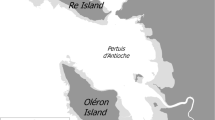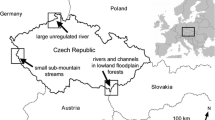Summary
These results are based upon studies carried out in summer and early autumn 1964–67 on the major European moulting area for Shelducks(Tadorna tadorna): the Grosser Knechtsand, Elbe—Weser estuary, northwest Germany.
The sand- and mud-flats of the Grosser Knechtsand serve as a rest and moulting place almost exclusively for non resident Shelduck populations. There is no local breeding population.
The greatest number of Shelducks was present from 20 July to 20 August. The size of the resting flocks (see figure 1) increases rapidly from the beginning of July and then decreases just as quickly untill the end of September. The highest daily estimates were made on August 14th, 1964 (about 60,000 birds), on August 9th, 1965 (about 40,000 birds), on August 5th, 1966 (about 38,000 birds), and on August 11th, 1967 (about 75,000 birds). The local ringing recoveries, the seasonal data, no drift fluctuations of flightless birds between Knechtsand and the moulting areas north of the Elbe estuary, and individual observations suggest an average stay of each bird of 12–14 days. The entire moulting population may thus be calculated as 85,000–100,000 Shelducks in 1964 and in 1965 and 1966, 70,000 to 80,000. The Shelduck is more numerous than any other species of waterbirds, comprising 33–48.5 % of all birds from August 1st to August 20th.
The seasonal fluctuation diagram does not correspond to sinusoidal oscillation, but is irregular. Maxima occur with more or less high air pressure, minima with more or less low air pressure. Since the extreme values and a constant interval between single extreme values recurred in 1965 and 1966, too, varying observation opportunities cannot explain the differences by themselves. There are probably different arrivals and departures of groups within the mass, but whether of different geographic populations or not, is not yet known. There is no correlation apparent between any single weather conditions and the numerial abundance of Shelduck aggregations at the peak of the moult. Toward the end of the moulting period, low air pressure conditions with stormy winds and cold air intrusions will accelerate the departure. There is one remarkable correlation, perhaps of similar importance for the moult congregations ofSomateria molissima andMelanitta nigra (seeSalomonsen 1968) andMergus serrator in the Danish-German coastal zone: the Shelduck concentrations on Knechtsand take place during the same time, especially in the first and second stage, when the sea water climbs up to the highest yearly temperatures (16–18° Celsius).
Shelducks that are able to fly arrive during the high tide especially, from southerly and southwesterly directions. They leave in the same direction after resting about 3 hours, which corresponds to the tidal fluctuation. Of about 37,834 counted Shelducks, 25,932 (= 68.5 %) arrived on Knechtsand from south-southwest, 8468 (= 22.4 %) from southwestwest, 1581 (= 4.2 %) from east-southeast, 1340 (= 3.5 %) from west-northwest, and 513 (= 1.4 %) from north-northeast (as observed in 1964 and 1965). The area covered by the ducks has a radius from 20 to 30 (and more?) kilometers around the Knechtsand. The flightless Shelducks are more or less passively moved by the tidal streams 3–8, sometimes 10 kilometers from rest places along sand banks exposed to deeper water. Favored resting places lie leeward of the Knechtsand island.
The majority of the flightless ducks move between the west-northwest sector of the Grosser Knechtsand and the borders of the nature refuge area, thus leaving once or twice daily.
On the west-northwest side of Knechtsand, few flights take place. This observation is supported by ringing recoveries. The low Scandinavian breeding densities also assure that the greater proportion of Shelducks will breed in Western Europe.
Male Shelducks are 2 to 3 times as common as females. The relation males-females was 15–10 : 1 (July 1 – July 20), 3–4 : 1 (July 20 – August 30), 1 : 1 (September).
The behavior of Shelducks able to fly is characterized during low tide by feeding and by plumage care and sleeping during high tide. Flightless birds show short, varying activities, most intensively plumage care, whereas feeding is sharply reduced. While there are already some instances of individual interactions (bonds) (♂—♀, ♂—♂, ♂ ♂—♀) among the ducks able to fly, most birds appear not to recognize one another individually. When replacing the remiges, the ducks are extremely shy on land (flight distance to men more than 1000 m). In deeper water, which is always situated beside the resting places on land, the flight distance decreases remarkably.
There are no human or animal predators of Shelducks on Knechtsand. There were probably no natural predators present in former times on the seaward flats to cause that behavior which is characterized as “extremely shy”. It is possible that this shyness is related to the crowding. Isolated birds require a longer time to complete the moult, so the biological value of crowding may be a reduction of the hazardous moulting time.
Comparing the Knechtsand results with the studies of German, Danish, Dutch, British authors, these conclusions might be derived: The maximum concentrations of Shelducks on Knechtsand are correlated with minimum numbers in the surrounding coastal areas. A period of relatively short arrival flights is, after the moult, followed by a slow dispersion through autumn in the Danish, German, Belgian-Dutch Wattenmeer. The Grosser Knechtsand is to be regarded as the main rest area, the flats at the northern side of the Elbe estuary are secondary moulting and important intermediate rest areas. All moulting areas lie within rather shallow waters relatively safed against storms and high, strong tidal movements at both (northern and southern) flanks of the Elbe estuary. Years of low breeding success in Great Britain (1964, 65) are followed, after one year, by a decline, years of high breeding success (1966, 67) by an increase in the moulting population on Knechtsand (1965,66, resp. 67, 68). The Shelduck indices in the counts of the British Wildfowl Trust, low in 1949–54, but rather high in 1960–68, make it probably that the former daily records of more than 75,000 Shelducks were overestimated. In the absence of daily counts by observers trained in estimation techniques, counts of birds in large aggregations cannot be more precise.
Similar content being viewed by others
Literatur
Dircksen, J. (1968): Brandgans-Mauserzug und tidenbedingte Bewegungen von Brandgans(Tadorna tadorna) und Eiderente(Somateria molissima) im Raum um Trischen. — Vogelwarte 24, p. 179–184.
Oelke, H. (1968): Vögel auf dem Großen Knechtsand. — Falke 15, p. 342–351, 372–377.
Salomonsen, F. (1968): The moult migration. — Wildfowl 19, p. 5–24.
Author information
Authors and Affiliations
Additional information
Gefördert mit Mitteln des Landes Niedersachsen und unterstützt vom Institut für Vogelforschung „Vogelwarte Helgoland“ und der Schutz- und Forschungsgemeinschaft Knechtsand e. V. sowie zahlreichen privaten Mitarbeitern (Danksagung in einer ausführlichen, für die Beihefte „Landschaft und Stadt“ 1969 vorgesehenen Abhandlung).
Rights and permissions
About this article
Cite this article
Oelke, H. Die Brandgans(Tadorna tadorna) im Mausergebiet Großer Knechtsand. J Ornithol 110, 170–175 (1969). https://doi.org/10.1007/BF01670780
Published:
Issue Date:
DOI: https://doi.org/10.1007/BF01670780




